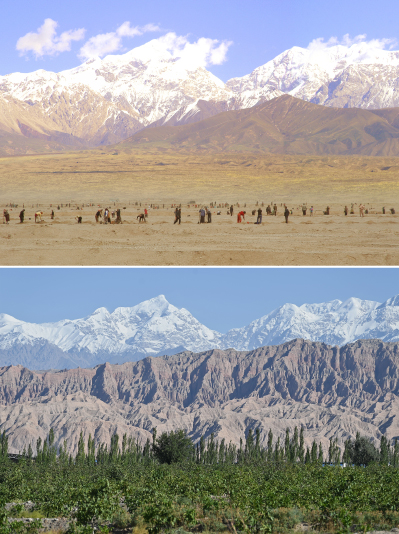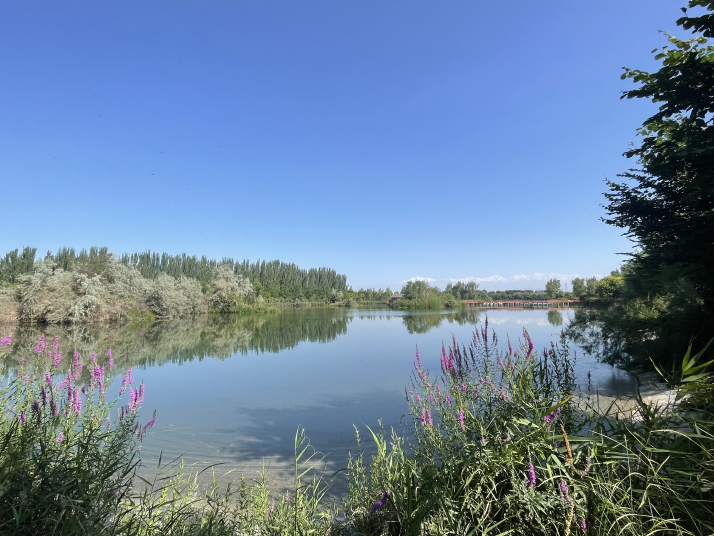| Xinjiang Today |
| A greener Aksu, one tree at a time | |
|
|
 The author poses by the Kanas Lake, Altay Prefecture, on July 1 (MAGDALENA ROJAS)
When we arrived at the Aksu Hongqipo Airport in Aksu Prefecture, we were taken immediately to the Kekeya Memorial Hall, a museum dedicated to the massive transformation that has turned the once barren prefecture into a green oasis.
I was joined by a media delegation of approximately 40 journalists from China and abroad, who had the fortune of getting a firsthand look at some of Xinjiang's most iconic places. As I walked through the halls of the museum, I couldn't help but marvel at the displays and photographs that recounted this decades-long journey of transformation. Although efforts had been made in the past to control the wind and sand, and to counteract the encroachment of the desert, it wasn't until the mid-1980s, following the launch of the reform and opening-up policy spearheaded by Deng Xiaoping, that a breakthrough was made. In the face of their existential crisis and after repeated trials and research, the Aksu authorities decided to create large ecological forests to improve both people's standard of living and the environment. Thus began a joint effort by the government and individuals alike to plant trees on a grand scale.  (Above) People plant trees in Kekeya Town in 2006; a forest in Kekeya in 2023 (XINHUA)
In the autumn of 1986, government officials, workers and students, regardless of their gender, ethnicity or age, gathered to level the land, dig ditches and plant trees. More than 50,000 people participated in this project that year alone. The task was monumental, with even officers and soldiers from the Aksu garrison joining in. "China's afforestation efforts, particularly in regions like Aksu, represent one of the most ambitious environmental undertakings in modern history," said Devinder Kumar, a foreign editorial consultant at the China International Communications Group Center for Europe and Asia, who was part of the delegation. "Since the late 1970s, China has planted billions of trees as part of programs like the Three-North Shelterbelt Program (commonly known as the Green Great Wall) to combat desertification, reduce soil erosion and mitigate climate change. Aksu, located near the Taklimakan Desert, has been a focal point of these efforts due to its vulnerability to desert encroachment." Since the Second Central Work Conference on Xinjiang in 2014, where the central authorities outlined new policies and initiatives to promote stability and development in the region, Aksu has been working on the overall protection, systematic restoration and comprehensive management of the environment.  One of the lakes at the Duolang River National Park (MAGDALENA ROJAS)
With that goal in mind, in 2015, ecological improvement work began in the Aksu River Basin, an 800-plus-square-km area that is a major source of water for agriculture, industries and human consumption. Next year, work began on the development and management of the basin of the Weigan River, one of the largest rivers in Xinjiang. Originally planned to be completed in five years, both projects were finished in three years thanks to the commitment of all actors. President Xi Jinping highlighted the importance of this endeavor at the Central Economic Work Conference in 2017. According to Owen Fishwick, a senior editor at China Daily, China's afforestation efforts have enabled people across the country to benefit from forestry, grassland and agricultural industries, increasing incomes and raising the standard of living. "The planting of trees has also turned fortunes around for many local people, who've been able to grow crops such as apples and apricots," he said. From the observation platform at the Kekeya Memorial Hall, you can clearly see how this greening effort has taken shape. Thousands upon thousands of trees, stretching out as far as the eye can see, dot the ground in perfect patches of green, like a skillfully woven tapestry, highlighting China's unwavering commitment to a greener future and a more sustainable environment. Aksu is part of a larger strategy that has been applied nationwide and aligns with the United Nations' Sustainable Development Goals for 2030 and a general vision of harmonious coexistence between humans and nature.  Participants of a media delegation look at a display highlighting the new green areas in Aksu City, Aksu Prefecture, at the Kekeya Memorial Hall (MAGDALENA ROJAS)
The concept of ecological civilization, first proposed at the 17th National Congress of the Communist Party of China in 2007, was expanded by Xi, who made it a core principle of China's development. He has repeated this concept time and time again, as a cornerstone of the vision of Beautiful China. Devinder Kumar highlighted how afforestation prevents soil erosion, improves air quality and reduces carbon emissions. "In Aksu, newly planted forests have stabilized the soil, decreasing the frequency and intensity of sandstorms, which has improved living conditions by enhancing the air quality and supporting agriculture. The carbon sequestration benefits also align with China's climate goals, such as achieving carbon neutrality before 2060, indirectly contributing to global environmental wellbeing," he explained. The work is far from over, but the numbers already speak for themselves. Aksu's forest coverage has increased steadily over the last 30 years. As of 2020, over 42 percent of its surface had been greened, while there was nearly 20 square meters of park land per capita. At the Leaders Meeting on Climate and the Just Transition in April, Xi once again stressed the importance of green governance and working hand in hand with other nations to achieve this goal. "Clear waters and green mountains are just as valuable as gold and silver. Green transformation is not only the essential way to address climate change, but also a new engine for economic and social development," he remarked. "China is a steadfast actor and major contributor in promoting global green development. Since I announced China's goal for carbon peaking and carbon neutrality five years ago, we have built the world's largest and fastest-growing renewable energy system as well as the largest and most complete new energy industrial chain. China also leads the world in the speed and scale of 'greening,' contributing a quarter of the world's newly added area of afforestation." Life in Aksu has changed dramatically, and for the better. The dreaded days of sandstorms, mudslides and constant struggle are over. On our last day in the city, we visited the Duolang River National Wetland Park, a place of endless trees, plants and flowers. It brought to us the sheer beauty of nature and reminded us of the importance of preserving it for the future, one tree at a time. Comments to ffli@cicgamericas.com |
|
||||||||||||||||||||||||||||
|